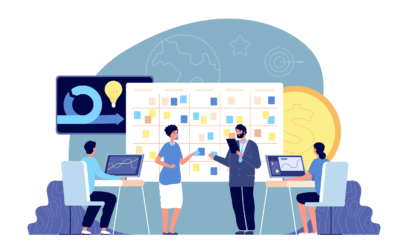Salesforce projects can become overwhelming without proper planning and design. By effectively scoping your project, you can define the specific requirements that drive your objectives and ensure alignment with your business goals. Understanding key challenges at the outset will enable you to avoid costly mistakes and inefficient workflows. This guide will equip you with crucial strategies and best practices for successfully executing your Salesforce implementation, empowering you to leverage the platform to its fullest potential from the start.
Key Takeaways:
- Define clear project objectives to align team efforts and expectations.
- Involve stakeholders early in the scoping process for comprehensive requirements gathering.
- Leverage Salesforce best practices to ensure efficient design and implementation.
- Plan for change management to facilitate user adoption and minimise disruption.
- Establish metrics and success criteria to evaluate project outcomes effectively.
Crafting a Vision: Aligning Business Goals with Salesforce Capabilities
Aligning your business goals with Salesforce capabilities requires a clear understanding of both realms. Your vision should bridge the gap, ensuring that every Salesforce feature directly supports your organisation’s objectives. Start by mapping out key business outcomes and how Salesforce tools can facilitate achieving them, whether improving customer engagement, streamlining operations, or enhancing data analytics. This alignment provides a solid foundation for a successful project.
Defining Project Objectives and Success Metrics
Define specific, measurable project objectives that reflect your business goals. Establishing success metrics helps track progress and ensure accountability. Metrics might include increased sales figures, reduced case resolution times, or elevated customer satisfaction scores. By pinpointing these targets from the outset, you provide your team with a clear roadmap and measurable evidence of success.
Engaging Stakeholders for Comprehensive Insights
Engaging stakeholders at every step brings diverse perspectives that enhance project outcomes. Collaboration with team members across functions ensures that important insights surface early, facilitating a tailored Salesforce solution. Make use of workshops or interviews to tap into their experiences, preferences, and pain points.
To effectively engage stakeholders, use structured interviews and collaborative workshops to gather insights that reflect real-world needs and challenges. This process not only reveals important workplace dynamics but also identifies potential obstacles to implementation. For instance, a sales team may highlight the need for specific reporting features, while marketing might emphasise lead tracking capabilities. Involving stakeholders early fosters a sense of ownership and encourages buy-in, significantly increasing the likelihood of project success.
The Art of Requirement Gathering: Uncovering User Needs
Requirement gathering serves as the backbone of your Salesforce project, ensuring that the solution aligns with user needs and business goals. Engaging with stakeholders not only clarifies their expectations but also fosters a sense of ownership and collaboration throughout the development process. By embracing diverse perspectives, you can unveil unique insights that drive your project’s success and create a tailored user experience.
Conducting Effective Interviews and Workshops
To extract valuable insights, conduct structured interviews and interactive workshops with key stakeholders. Use open-ended questions to encourage detailed responses while creating a comfortable environment for sharing ideas. Employ techniques such as brainstorming sessions or scenario planning to facilitate discussion and capture the range of user needs, ensuring that all voices contribute to the project objectives.
Prioritising Features: What’s Essential vs. Nice-to-Have
Sorting features into vital and nice-to-have categories streamlines project focus and resource allocation. Engaging stakeholders in this prioritisation process helps identify which functionalities deliver the highest value and align best with your strategic goals. This clarity aids in decision-making and ensures that your project remains on track and within budget.
Begin by collecting all potential features through brainstorming sessions or user stories, then employ a scorecard approach to evaluate each feature’s impact on user experience, cost, and implementation complexity. This method allows you to rank features objectively, clarifying what absolutely must be included in the initial rollout versus what can be deferred for future phases. For instance, consider integrating vital features like lead management and reporting before introducing advanced analytics tools, ensuring that core functionalities are functional and provide a solid foundation for further enhancements.
Designing the Blueprint: Mapping Out the Architecture
Designing your Salesforce project architecture involves creating a detailed and strategic framework that guides your implementation process. This blueprint encompasses all components, from user interface design to data flow, helping to ensure that your project aligns with business objectives and user needs. A well-mapped architecture not only simplifies development but also provides clarity for stakeholders, facilitating better communication and collaboration throughout the project lifecycle.
Structuring Data Models for Scalability and Efficiency
Your data model should be designed for efficiency and scalability from the outset. Utilising custom objects appropriately and defining clear relationships between entities allows your Salesforce system to manage increased workloads and user demands as your organisation grows. Moreover, incorporating best practices, such as normalisation and indexing, enhances your data integrity while promoting optimal performance.
Integrating with Existing Systems: Challenges and Solutions
Seamless integration with existing systems can present significant challenges, including data mismatches and differing workflows. Establishing clear objectives for integration helps identify potential issues early on, enabling proactive solutions. Utilising APIs, middleware, and integration platforms can facilitate communication between Salesforce and legacy systems, ensuring data flows smoothly across platforms.
For instance, a financial services company facing integration hurdles with outdated CRM and ERP systems found success by implementing an API-led connectivity approach. This method involved creating dedicated APIs for data exchange, reducing duplication and ensuring real-time updates. Additionally, comprehensive testing phases allowed for the identification of specific pain points, such as inconsistent data formats and user access issues, leading to tailored solutions. By prioritising integration and leveraging technology, you can enhance operational efficiency and ensure that all systems work harmoniously together.
Constructing a Roadmap: Setting Phases for Implementation
Creating a detailed roadmap for your Salesforce implementation allows you to tackle the project in manageable phases, minimising risks while maximising efficiency. Each phase should tackle specific objectives, ensuring that you can make adjustments based on feedback and emerging business needs. This iterative approach not only supports continuous improvement but also keeps stakeholders engaged throughout the process, facilitating smoother transitions and adoption.
Creating a Realistic Timeline with Milestones
A realistic timeline is fundamental to your Salesforce project’s success. Setting key milestones helps you track progress and maintain momentum. Break the project into distinct phases with specific deadlines to ensure accountability. Each milestone should bolster team confidence and provide opportunities for reassessment and recalibration, aligning efforts with project goals and stakeholder expectations.
Budgeting for Success: Allocating Resources Wisely
Effective budgeting directly impacts your project’s outcome, providing a clear picture of necessary resources. Allocate funds towards vital components, such as software licenses, consulting services, and training programs. Regularly revisit your budget to accommodate changes, ensuring that unexpected costs don’t derail progress or diminish adherence to your roadmap.
Detailing your budget involves analysing historical data and project specifics to create an accurate forecast. Consider all resource allocations, from software licenses that can range from £25 to £300 per user monthly, to professional services that typically engage experts charged at £150 to £250 per hour. A dynamic budget accounts for unforeseen expenses related to integration challenges or user adoption initiatives. Establishing a contingency fund of 10-15% of your total budget can be effective in absorbing any financial shocks, ensuring project continuity without sacrificing core objectives.

Pre-Launch Fine-Tuning: Testing and Validation Strategies
Effective testing and validation are important for ensuring your Salesforce project meets expectations before launch. Fine-tuning your system allows you to identify and rectify any potential issues, ultimately leading to a smoother user experience and enhanced adoption rates. Comprehensive testing not only verifies functionality but also builds confidence among your stakeholders, solidifying their support for the project.
Developing a User Acceptance Testing (UAT) Plan
Your User Acceptance Testing (UAT) plan should outline the criteria and processes for evaluating the solution from the end user’s perspective. Engage a diverse group of users to validate the system against real-world scenarios and requirements. Clearly define success metrics and ensure adequate documentation to track findings, helping facilitate a seamless transition post-launch.
Gathering Feedback for Continuous Improvement
Feedback is important for identifying areas of improvement throughout the lifecycle of your Salesforce project. Actively seek input during UAT to uncover any usability challenges or feature gaps. Establish channels for users to share their thoughts post-launch, ensuring a culture of open communication that supports iterative enhancements.
Continuous feedback fosters a user-centred development approach. After UAT, consider utilising surveys and interviews to further validate your findings. Analyse the feedback collected to identify trends and common pain points among users. Implementing a system for ongoing feedback allows you to iteratively refine your Salesforce solution, making it more aligned with user needs and ultimately increasing satisfaction and productivity. Establishing a feedback loop means your project evolves organically, adapting to changing business requirements and improved user experiences.
Conclusion
With these considerations, you can effectively scope and design your Salesforce project for optimal success. By focusing on clear objectives, engaging stakeholders, and utilising best practices, your project will not only meet initial expectations but also adapt to future needs. Ensure you gather thorough requirements, prioritise functionality, and maintain open communication throughout the process. By addressing these key elements, you position your Salesforce project for lasting impact and achievement from the outset.
FAQ
Q: What is the purpose of the “Blueprint for Success” guide?
A: The guide provides a structured approach to scoping and designing Salesforce projects, ensuring that all necessary elements are considered for a successful implementation.
Q: Who should use this guide?
A: Project managers, business analysts, Salesforce administrators, and any stakeholders involved in Salesforce implementation will find this guide beneficial for aligning project objectives and requirements.
Q: What are the key phases outlined in the Blueprint for Success?
A: The key phases include project initiation, requirements gathering, design specifications, validation, and deployment planning to facilitate a comprehensive understanding of each project’s lifecycle.
Q: How does the guide help in minimising project risks?
A: By emphasising thorough planning and detailed requirements gathering, the guide helps identify potential issues early, allowing teams to address risks proactively rather than reactively during implementation.
Q: What resources are available within the Blueprint for Success?
A: The guide includes templates, checklists, and best practice recommendations to streamline each phase of the project, making it easier to follow the outlined processes effectively.






